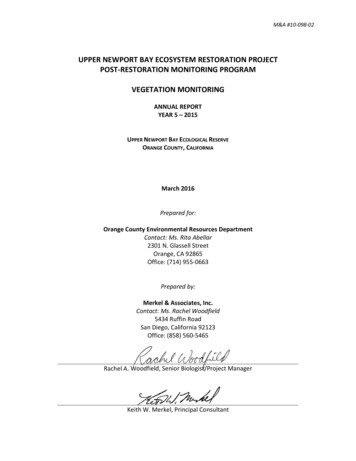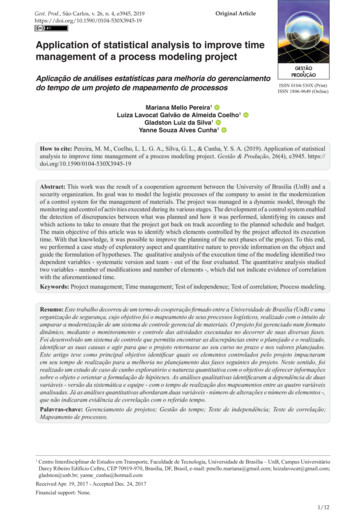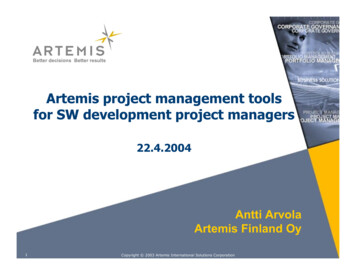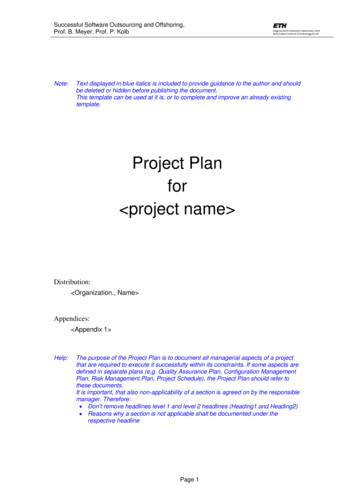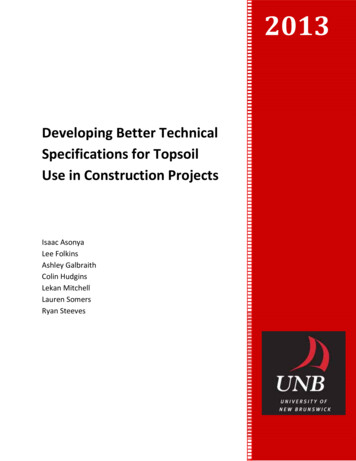
Transcription
2013Developing Better TechnicalSpecifications for TopsoilUse in Construction ProjectsIsaac AsonyaLee FolkinsAshley GalbraithColin HudginsLekan MitchellLauren SomersRyan SteevesToshiba
Developing Better Technical Specifications for Compost Manufactured Topsoil in Construction ProjectsApril 7, 2013DisclaimerThis report presents the work of a student project at the University of New Brunswick. Anyinformation contained in this report must be reviewed by a professional engineer beforeimplementation. This report is made available without any representation or warranty and on thestrict understanding that the reader accepts full liability for the application of any of the contentsof the report.AcknowledgmentsThe team would like to thank the client, Rodney Fry, P.Eng, the Director of Technical andBusiness Development at Envirem Organics Inc. for providing us with the proper resources forcompleting the project. We would also like to thank our professor Dr. Lloyd Waugh. Hisfeedback helped to guide us through the process, providing advice and feedback wheneverchallenges were encountered. In addition, we would like to acknowledge the support of GilmanViolette who provided us with some additional resources.i
Developing Better Technical Specifications for Compost Manufactured Topsoil in Construction ProjectsApril 7, 2013Table of ContentsDisclaimer .Acknowledgments.i1. Introduction. 11.1 Topsoil Definition . 11.2 Compost Manufactured Topsoil Definition . 12. Current Topsoil Specifications. 12.1 Topsoil Preservation Act. 12.2 Leadership in Energy and Environmental Design (LEED) Canada. 32.2.1 LEED Canada Background. 32.2.2 LEED and Compost Manufactured Topsoil. 32.3 Sustainable Technologies Evaluation Program. 42.4 Municipal Topsoil Specifications . 43. Benefits of using Compost Manufactured Topsoil . 43.1 Increased Vegetation Growth. 43.2 Environmental Benefits. 53.3 Economic Benefits . 54. Past Projects . 54.1 The Merrimack Valley Transportation Centre. 64.2 CFB Gagetown – Training land reclamation project. . 64.3 Texas Highway Project . 84.4 Sydney Tar Ponds . 85. Proposed Compost Manufactured Topsoil Specifications . 95.1 Recommended Changes to Current Specifications . 95.1.1 Recommendations to Municipalities. 95.1.2 Recommendations to LEED. 106. References. 12APPENDICES . 16Appendix I – Current Specifications. 17Current Specifications. 17ii
Developing Better Technical Specifications for Compost Manufactured Topsoil in Construction ProjectsApril 7, 2013Atlantic Canada. 17Central and Western Canada. 18Topsoil Specifications for the Sidney Tar Ponds Project. 21Appendix II – Recommended Topsoil Specification . 221. Materials . 221.1 Compost . 221.2 Inorganic Soil Component . 221.2.1 Additional soil parameters . 231.2.2 Particle Size . 232. Compost Manufactured Topsoil. 242.1 General. 242.2 Mechanical Specifications . 242.3 Environmental Specifications . 243 Use of Compost Manufactured Topsoil . 243.1 General. 243.2 Turf Requirements . 253.3 Planting Requirements . 25iii
Developing Better Technical Specifications for Compost Manufactured Topsoil in Construction ProjectsApril 7, 20131. IntroductionCurrently, topsoil specifications in Atlantic Canada recommend the use of naturally occurringtopsoil which has been stripped from fields or do not specify the use of quality topsoil. Withthese specifications, poor quality topsoil is often being used by contractors for landscaping. Thiscan result in expensive post-construction maintenance. The use of quality compost manufacturedtopsoil can play an important role in reducing these expenses. As well, it is important to note,that it takes over 2000 years to naturally regenerate a 150mm thickness of native topsoil/humuslayer, while using current engineered compost production methods can achieve the equivalentwithin a 6-month period (verbal communication – Envirem Organics Inc.). The objective of thisreport is to examine the benefits and promote the use of compost manufactured topsoil as analternative to the lessor environmentally sustainable farmland and floodplain stripping practices.1.1 Topsoil DefinitionTopsoil is defined by the New Brunswick Department of Transportation as “the surface layer ofthe soil profile and is responsible for supplying water and nutrients to plants” (NBDOT, 2011).1.2 Compost Manufactured Topsoil DefinitionCompost manufactured topsoil is a combination of both natural soil and organic compost,typically with a split of 70-30% (by weight), respectively, or 50-50 (by volume). Compostmanufactured topsoil presents an environmentally friendly alternative to field stripping. Compostmanufactured topsoil is composed of many readily available ingredients such as low organicmatter sub-soils, sand, and compost (Alexander, 2001).2. Current Topsoil SpecificationsThe following section outlines the regulations and programs which may influence the use ofcompost manufactured. Current municipal specifications are also discussed.2.1 Topsoil Preservation ActThe Topsoil Preservation Act came into effect on May 1st 1995 (NB Legislative Assembly,2006). The goal of the act was to regulate the stripping of topsoil in the province of NewBrunswick, thereby protecting the environmental integrity of soil in the province which prevents1
Developing Better Technical Specifications for Compost Manufactured Topsoil in Construction ProjectsApril 7, 2013excessive erosion and sediment transport. The Topsoil Preservation Act states the following in itslegislation: No person shall remove topsoil from a site or move topsoil from a parcel unless theperson is the holder of a permit, No person who owns a parcel shall permit topsoil to be removed from any site within theparcel or moved from the parcel by any other person unless the person who owns theparcel is the holder of a permit. No person shall transport topsoil in, on or by a vehicle on a highway except inaccordance with the regulations. (NB Legislative Assembly, 2006)In summary, the act prohibits the sale or removal of topsoil without a government permit. Thisact gives the government the power to regulate the removal of topsoil (NB Legislative Assembly,2006).The act also gives power to the minister to designate inspectors to topsoil removal projects, toinsure compliance with the topsoil preservation act. The minister then can give a ministerialorder to cease or suspend production, to alter the manner of removal, or to carry outrehabilitation of the removal site (NB Legislative Assembly, 2006).The act grants the lieutenant governor general the power to regulate the number of permitsissued, thereby preventing persons from obtaining permits, and exempting any persons from theact. Lieutenant governors ruling can overrule that of the minister (NB Legislative Assembly,2006).It is important to note that this particular piece of legislation has never been properly enforcedwithin New Brunswick and topsoil stripping activities have been allowed to continue withoutrestriction within our provincial floodplains and farmland (verbal communication – EnviremOrganics Inc.).2
Developing Better Technical Specifications for Compost Manufactured Topsoil in Construction ProjectsApril 7, 20132.2 Leadership in Energy and Environmental Design (LEED) Canada2.2.1 LEED Canada BackgroundLEED Canada is an internationally recognized, third-party certification program. Its objective isto promote human and environmental health through a series of rating systems for the design,construction, and operation of high performance green buildings, homes, and neighbourhoods(CaGBC, n.d). LEED Canada currently has six rating systems: New Construction, Core andShell, Commercial Interiors, Existing Buildings, Homes, and Neighbourhood Development(Ottawa Government, n.d.). Neighbourhood development focuses primarily on site selection,design, and construction while the other five rating systems focus on green building practices(CaGBC, 2011; CaGBC, 2009). Since the focus of this report is on the use of topsoil inconstruction projects, the report will focus on the first five categories of LEED Canada.The LEED Canada points-based systems are tailored to Canadian climates, constructionpractices, and regulations. Point allocation among the categories is based on environmentalimpact and human benefits (CaGBC, 2009). The five building practice categories award pointsbased on five principal environmental categories and a sixth secondary category. Thesecategories include: Sustainable Sites, Water Efficiency, Energy and Atmosphere, Materials andResources, Indoor Environmental Quality, and Innovation in Design (or Operations) (CaGBC,2009). For the purposes of this report, only the Materials and Resources (MR) category will beconsidered as it is the sole category which encourages design strategies to reduce and reuseresources and construction waste while encouraging the selection of building materials thatcontain recycled content (Ottawa Government, n.d.).2.2.2 LEED and Compost Manufactured TopsoilCurrent LEED specifications encourage the use of materials manufactured with recycled contentfor the construction of new buildings and the refurbishment of existing buildings and commercialinteriors (CaGBC, 2009). The criterion does not however, promote the use of recycled materialssuch as compost manufactured topsoil for land restoration and development. Section 3 of thisreport discusses the various benefits of using this product.3
Developing Better Technical Specifications for Compost Manufactured Topsoil in Construction ProjectsApril 7, 20132.3 Sustainable Technologies Evaluation ProgramThe Sustainable Technologies Evaluation Program (STEP) is a multi-agency initiative led by theToronto and Region Conservation Authority aimed at broadening the application of sustainabletechnologies. STEP recommends using composted materials to remediate disturbed natural soilsin order to restore soils natural function and increase soil fertility. Compost manufactured topsoilachieves these benefits and remediates disturbed natural soils, such as those on constructionsites, by decreasing the density of the soil and increasing the organic content. In addition toincreased soil integrity, more surface runoff is also absorbed by the soil minimizing the impact ofsoil compaction and flooding.2.4 Municipal Topsoil SpecificationsTopsoil specifications obtained from municipal and provincial specification documents forselected Atlantic, Central, and Western Canadian cities can be found in Appendix I of this report.3. Benefits of using Compost Manufactured TopsoilThe use of compost manufactured topsoil can result in improved vegetation growth, andenvironmental and economic benefits. These benefits are outlined below.3.1 Increased Vegetation GrowthThe compost component of compost manufactured topsoil (about 50 percent by volume onaverage) provides the soil with superior chemical, biological, and physical characteristics. Thehigh concentration of nitrogen within the compost allows the topsoil to sustain thicker andhealthier plant growth. This characteristic alone has many positive environmental side effects,and consequently is also a very economical alternative to traditional topsoil. Topsoil possessesseveral other characteristics to support the growth of vegetation as well. These include providingan anchorage for plant roots, slowly releasing nutrients, providing oxygen, and draining excesswater while also retaining moisture to sustain plant growth during dry periods (British Standards,2007). In addition, the mixing of compost with a sandy soil which possesses a specific aggregatedistribution will prevent compaction of the soil, thereby producing greater plant growth byfacilitating root expansion (Agresource, n.d.). Due to the fragility of natural topsoil, intensivehandling through excavation, loading, transportation, and distribution can result in a dramatic4
Developing Better Technical Specifications for Compost Manufactured Topsoil in Construction ProjectsApril 7, 2013deterioration in the functions provided by the topsoil. However, the careful production andhandling of compost manufactured topsoil ensures that the soil retains the beneficialcharacteristics needed to sustain plant growth (British Standards, 2007).3.2 Environmental BenefitsThe use of compost manufactured topsoil offers a variety of environmental benefits. Theincreased root mass associated with improved plant growth, allows for greater water absorptionwhich in turn decreases the amount of runoff and erosion (Alexander, 2001). CompostManufactured topsoil can also help prevent plant disease due to the high concentration ofmicroorganisms, thus helping to promote and preserve the ecosystem (EPA, 2012). Otherenvironmental benefits would be the reduced amount of field stripping needed to keep up withtopsoil demand. Since the current unregulated practice of stripping natural topsoil has become acommon trend in the construction industry, the development of specifications which utilizecompost manufactured topsoil will ultimately prevent the loss of this non-renewable naturalresource.3.3 Economic BenefitsThe thicker healthier vegetation creates cost saving as well. Once an area has been covered andseeded, there is generally no need to return in the future to re-work areas that may not haveproduced sufficient vegetation (McCoy and Barrie, 2001). In addition to the economic benefitsassociated with thicker and healthier plant growth, the use of compost manufactured topsoil canalso reduce the need for future maintenance costs. As discussed above, the reduction of erosioncan also result in significant cost savings for a contractor working in an environmentallysensitive area (Alexander, 2001). This decrease in erosion further decreases post-constructioncosts as there is no need to return and fill in any eroded areas on site. This concept is discussedfurther in section 4.3 below.4. Past ProjectsThe following sections describe the outcomes of past projects which used compost manufacturedtopsoil. The Merrimack Valley Transportation Centre, Gagetown Reclamation Project, and5
Developing Better Technical Specifications for Compost Manufactured Topsoil in Construction ProjectsApril 7, 2013Texas Highway Project are examples of successful use of compost manufactured topsoil. TheSidney Tar Ponds example shows the employment of insufficient topsoil specifications.4.1 The Merrimack Valley Transportation CentreThe Merrimack Valley Transportation Centre in Massachusetts was recently constructed nearAmesbury, MA. During the spring of 2012, landscaping was taking place. Topsoil, trees, andshrubs were already on site, waiting to be planted.The landscaping contractor was the Green Company, and the company owner noticed that thetopsoil on site was a low grade natural loam and would likely not result in good vegetationgrowth. Although the topsoil chosen may have fit the specification, it was not well suited for thisapplication. Instead,
completing the project. We would also like to thank our professor Dr. Lloyd Waugh. His feedback helped to guide us through the process, providing advice and feedback whenever challenges were encountered. In addition, we would like to acknowledge the support of Gilman


